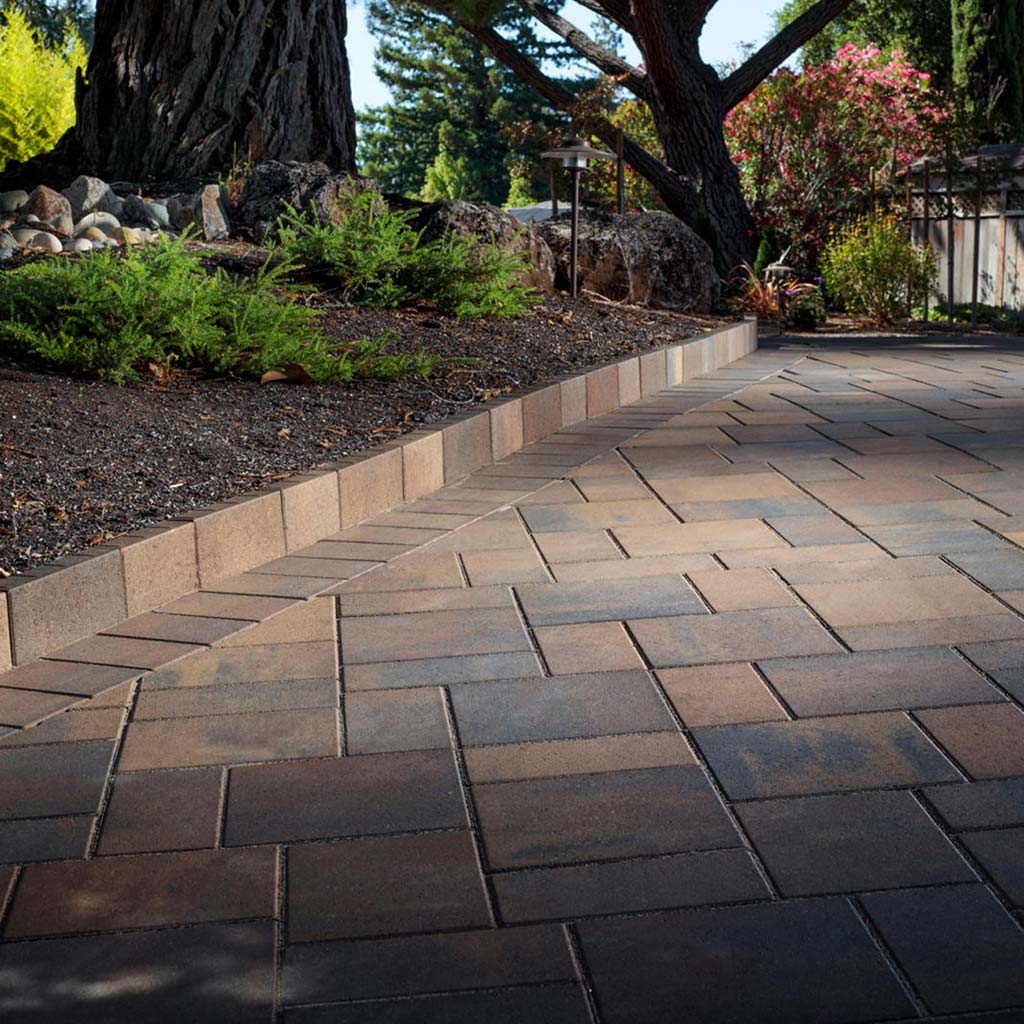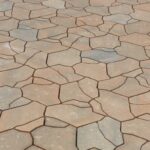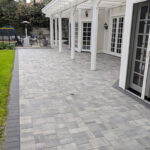Concrete Pavers vs Concrete Comparison Guide
If you’re looking to repave your driveway and update its look, you may have concrete pavers and concrete on your list of possible options. This post takes you through the pros and cons of both concrete and concrete pavers to help you make an informed decision.
Pavers vs. Concrete Visual Appeal
Let’s face it—aesthetics matter. You want a hardscape your guests, relatives, and neighbors will love, if not envy.
- Generally, concrete paving stones will provide you with a much more attractive look whether you use them for a driveway, patio, or pool deck. Pavers are available in various designs, textures, colors, and shapes. You can plan the look of your driveway or another hardscape more flexibly and achieve the look you want.
- Conversely, concrete offers limited design options. While colors can be added to poured concrete, the color fades quickly and will need to be reapplied every few years, adding to maintenance costs. The alternative is to use decorative or stamped concrete. This is a viable option as it can add visual appeal, but take a look at stamped concrete next to a professional paver installation, and the difference is night and day. And you might be surprised how close in price stamped concrete is to paving stone.
For these reasons, concrete paver installation is preferred for visual appeal, just for the sheer number of colors, sizes and style possibilities. But this clearly is not the only factor that goes into your decision between paving stone and concrete slab.
Paving Stones Vs. Concrete Durability
- In the durability stakes, paving stones easily beat poured concrete. A paving stone is produced in a controlled environment to ensure maximum strength and durability. Paving stones also resist freeze/thaw cycles effectively, so cracks or displacement caused by a heave and sink in the driveway surface resulting from freezing and melting water are rare.
- On the other hand, temperature changes and a movement in the underlying soil can cause poured concrete to split and crack, even with appropriate concrete spacers. There’s really no getting around it. When this occurs, sometimes you can repair it, but you may not be able to return it to its original appearance. You will probably need to replace the entire concrete surface at least every 10 years. Yes, tear it up, haul it off, and start over.
More durable paving stones automatically have some space between each paving stone, giving them ample room to expand and even shift without interfering with the appearance or function of your hardscape. That makes them super easy and cost-effective to repair in those rare events when paving stones do need repair.
Replacement and Repairs for Concrete Slab Vs. Paver Installation
First of all, many people will be unable to replace their concrete slabs as soon as they crack. Unless money is no object, they live with cracked concrete for a while.
Compare that with paving stone. First, we’ve established paving stones are durable, so repairs and replacement needs should be much less frequent than working with paving materials.
But on top of that, when you do need a repair or replace, you can replace and reuse individual concrete paving stones that come loose, sustain cracks or shift. That’s a much less frequent and involved ordeal than pulling up and repouring the whole surface. As a bonus, fixing a single damaged paving stone is less involved and less expensive than pouring new concrete, so you don’t have to wait. Keep your hardscape always looking great.
Cost Comparison for Repairs
The average cost to repair paving stones is $15 to $125+. Over the lifetime of your paving stone surface (25-30 years), you can expect to repair 2-3 times and spend around $600 on repairs total. Yes, really.
Conversely, concrete pavement can be repaired in sections, although it may not look very uniform. If you can’t fix it, you’ll need to replace it. So what does that cost?
According to HomeGuide, the national average cost to install a relatively small area of basic, no-frills concrete (20′ X 20′) is $2,468. Of course, we’re in California, so we know our costs tend to be more than the national average. And this doesn’t include stamping, embellishing, demolishing, or hauling away.
Upfront Costs of Pavers Vs. Concrete Paving Materials
Installing concrete slabs is usually a lower-cost option than pavers — at least up-front. However, this doesn’t mean paving with concrete is more cost-effective than using paving stones.
Cost-effectiveness takes into consideration the value of what you’re paying for. If a concrete slab cracks in a couple of years and needs more frequent repair and replacement, that costs you time and money, so paving materials may not, in fact, be cost-effective.
With poured concrete, you’ll be spending more breaking up and repouring the surface every 10 years or so, or living with the cracks until you can.
With that said, the up-front cost of pavers is more than concrete, labor, materials and equipment. However, interlocking concrete pavers have a lifetime of thirty or more years. You can also repurpose old pavers if you choose to replace them. They can be removed and installed in areas of your home that need paving but are not important style-wise or won’t be visible to guests. So, you can save on the cost of purchasing new pavers, getting more bang for your buck.
So we looked at a no-frill 20′ X 20′ concrete slab above. That’s around $2,468 nationally. According to HomeGuide, the national average for paving stones installation is $3,800 to $6,800 for a 20′ X 20′.
When comparing bare-bones concrete jobs to pavers installation, pavers clearly have a higher upfront cost. However, if we look back at how long pavers last and how inexpensive repairs are compared to fixing your broken concrete, the cost-effectiveness clearly shifts toward pavers.
Safety
Concrete slabs can be slippery when it’s raining unless you get coarse aggregate concrete, making pouring concrete more expensive than you would initially think. If this surface is intended for a pool area, the last thing you want is a slippery surface or coarse aggregate poking tender feet. In comparison, pavers are textured and specially designed to reduce skid and be comfortable underfoot.
Maintenance
- Although concrete paving stones are less easy to clean than concrete, they also show less dirt because of the patterns and textures. Consider the difference between getting a solid white countertop and one that has variations, like granite or granite-looking surfaces. Solid white would show everything, and it’s much the same for poured concrete. Paving stones are also more durable and therefore require less overall maintenance. Interlocking pavers with sand enhances the durability of your driveway.
- Concrete can be cleaned with dish soap and rinsed with water. But you need to apply sealants frequently to prevent stains that can detract from the overall look of your hardscape. You should seal concrete every 2-5 years.
Maintenance-wise, paving stones are more convenient and economical overall. When it is time to wash them, you’ll soak them in water and scrub them with a non-acidic cleaning solution. You then rinse them with the hose. You should re-seal paving stones every 5 years.
Home Value Considerations
According to FIXr research, installing pavers can increase your home value by $1,310 – $1,770, while installing the same amount of concrete increases home value by $865 – $1,085.
Overall Value
For fun, let’s estimate the lifetime cost of a 20′ X 20′ hardscape made from paving stones Vs. concrete slab. Note: these figures are for comparison only. Your unique project may vary based on many factors.
Comparing the Total Costs of Pavers to Slabs
- Pavers Lifetime Costs: The initial cost for pavers and installation based on the above data was $3,800 to $6,800 + $600 for repairs. That’s $4400 to $7,400 over its lifetime.
- Concrete Lifetime Costs: The initial cost for the same size concrete slab is $2,468, but you will probably need to repour it every 10 years, plus repairs every 3-5 years. So you end up spending $2,468 two more times in 25 years. You now have a total cost over 25 years of $7404. Well, look at that, over 25 years, pavers could, in fact, be cheaper or more or less the same.
Even before we factor in the visual appeal, less hassle, and the value of making your guests, family and neighbors jealous, you might just say we have a clear winner.
Individual project prices vary. The final cost of concrete or paving stones installation will depend on the square feet of land to be covered. Make sure you check and compare the rates offered by different contractors to determine who is offering the most value.
Although budget is an important factor, also consider quality and the contractor’s reputation. That can factor into cost-effectiveness as well because when a job is done right, you’ll spend less over its lifetime. Only engage a licensed, insured paver company that can assure quality, safe and no-hassle installation.



